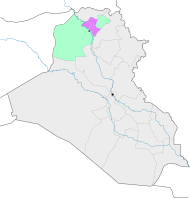Monastery of Saint John of Dailam
 Ruins of the monastery in the 1960s | |
| Monastery information | |
|---|---|
| Other names | ܕܝܪܐ ܢܩܘܪܬܝܐ |
| Established | 7th century AD |
| Disestablished | 19th century |
| Dedicated to | Mar Yoḥannan Daylamáyá |
| Diocese | Syriac Orthodox Diocese of Mosul |
| People | |
| Founder(s) | Mar Yoḥannan Daylamáyá |
| Site | |
| Location | Bakhdida, Nineveh Province, Iraq |
| Coordinates | 36°17′59″N 43°22′24″E / 36.29972°N 43.37333°E |
| Visible remains | the altar and a baptismal font |
| Public access | yes |
The Monastery of Saint John of Dailam, also known as Naqortaya and Muqurtaya (Syriac: ܕܝܪܐ ܢܩܘܪܬܝܐ, romanized: dayrā naqortāyā, lit. 'chiseled monastery'), is a Syriac Orthodox monastery that lies 3 km north of Qaraqosh in northern Iraq.
History
[edit]The foundation of Naqortaya monastery is traditionally attributed to John of Dailam, who was active in the region in the seventh century and was responsible, according to a historical legend, for converting its people from the Church of the East to the Syriac Orthodox Church. However, the oldest attested mention of the monastery dates back to the late 9th century, and another Syriac manuscript states that it was consecrated in 1115.
Bar Hebraeus records that in 1261 the monastery was raided by the Kurds, who burned it down and killed its monks,[1] and was abandoned until it was rebuilt in 1563. When the majority of the inhabitants of Bakhdida started converting to the Syriac Catholic Church in the 18th century the monastery remained under the control of the Syriac Orthodox Church and was left deserted. The monastery was excavated and rebuilt in 1998 and has an ancient carved altar and a large courtyard with a fountain and a statue.[2] The monastery was from 2014-2-17 by the Islamic State.[citation needed].
John of Dailam feast
[edit]The Naqurtaya monastery is visited by thousands of Syriac Orthodox pilgrims from the Nineveh Plains region during the feast of Yoḥannan Daylamáyá the last Friday of March.
References
[edit]- ^ Bar Hebraeus. Chronicon Ecclesiasticum.
- ^ "Naqurtaya monastery – Baghdehda". www.ishtartv.com.
External links
[edit]- القديس مار يوحنا الديلمي، تاريخ الدير (in Arabic). moryouhanon.com. Archived from the original on February 11, 2016. Retrieved March 15, 2012.


 French
French Deutsch
Deutsch
